Computer Applications | Computer Science
3 Resources to Help You Meet CSTA Standards
School districts across the country are changing their computer course requirements to focus on computer science.
With this change, computer apps teachers aren’t always sure what they should teach their students, let alone how to teach it!
To help these teachers, the Computer Science Teachers Association (CSTA) has built a teacher-led community dedicated to helping any K-12 educator teach computer science.
As part of this work, the organization developed the CSTA K-12 Computer Science Standards, which outline the list of core objectives for any computer science class in grades K-12!
These standards serve as a guide for any teacher trying to figure out what to cover in their computer science classes.
But what do the standards actually look like, and how do you know which ones to use as guidelines?
First, you have to know what they are.
About the CSTA Standards
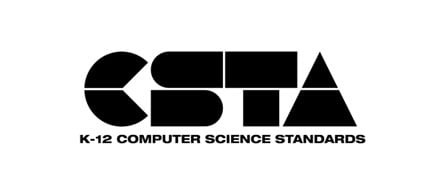
The CSTA standards were written by teachers to provide a foundation for computer science curriculum across all ages of students.
In total, there are 120 detailed CSTA standards. These standards are sorted in two main ways — level and concept.
When sorting the standards by level, you’re looking at them by grade level. There are five specific levels designated within the standards:
- 1A (Grades K-2)
- 1B (Grades 3-5)
- 2 (Grades 6-8)
- 3A (Grades 9-10)
- 3B (Grades 11-12)
When viewing the standards by concept, you’re seeing the five main topic areas related to computer science:
- Algorithms & Programming
- Computing Systems
- Data & Analysis
- Impacts of Computing
- Networks & the Internet
Overall, by using the filtering options on the CSTA Standards webpage, you’ll be able to nail down the exact concepts that apply to your classroom based on the grade level.
But once you’ve figured out what you should teach, you’re still going to need to know how to teach it!
To help save you time, we’ve found three excellent resources that help teachers meet the CSTA Standards:
- Google for Education
- CodeHS
- Code.org
Each resource has its pros and cons when it comes to teaching to the CSTA Standards.
In some cases, one resource could work better for you, but in other cases you’ll find using more than one option is the best fit.
Let’s get started!
1. Google for Education

Google for Education has created an introductory computer science resource called CS First.
This curriculum was specifically designed for students between the ages of 9-14 to learn the basics of computer science and programming.
The CS First curriculum is broken into two types of content -- sample activities and themes.
The sample activities are easy-to-implement class activities that take one hour to complete.
The themes are more in-depth curriculum resources that are made up of eight activities and take a total of 10 hours to work through.
Overall, the CS First curriculum aligns very well to two cross-sections of the CSTA standards:
- Level 1B, Algorithms & Programming
- Level 2, Algorithms & Programming
Because the CS First curriculum is so basic, it doesn’t cover a ton of the standards.
We recommend using this resource as the first step in teaching your students about computer science.
It can be a great jumping off point to introducing the next resource on our list!
2. CodeHS

CodeHS is a web-based curriculum designed to help teach middle and high school students computer science skills.
The full CodeHS curriculum pathway is made up of 16 courses across grades 6-12. Six of these courses have been reviewed for alignment to the CSTA Standards:
- Computing Ideas
- Web Design
- Intro to Computer Science in JavaScript
- Intro to Computer Science in Python
- AP Computer Science A (Java)
- AP Computer Science Principles
In the overview, you’ll find a description of the course and a breakdown of how the course meets each standard within the five overarching concepts.
Computing Ideas
The Computing Ideas course is an introductory course recommended for students in grades 7-9.
This course meets these cross-sections of the CSTA standards very well:
- Level 2, Algorithms & Programming
- Level 3A, Algorithms & Programming
- Level 3B, Algorithms & Programming
Web Design
The Web Design course is an introductory course for middle school students.
This course isn’t as aligned to the CSTA standards as the previous one, but it hits some concepts in these cross-sections:
- Level 2, Impacts of Computing
- Level 3A, Algorithms & Programming
Intro to Computer Science in JavaScript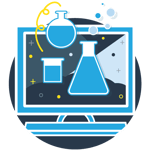
The Intro to Computer Science in JavaScript course teaches high school students about logical thinking, problem-solving, and JavaScript programming skills.
This course is well aligned to three portions of the CSTA standards:
- Level 2, Algorithms & Programming
- Level 3A, Algorithms & Programming
- Level 3B, Algorithms & Programming
Intro to Computer Science in Python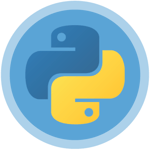
Intro to Computer Science in Python is similar to the previous course and focused on the Python coding language.
The course aligns to three cross-sections of the CSTA standards:
- Level 2, Algorithms & Programming
- Level 3A, Algorithms & Programming
- Level 3B, Algorithms & Programming
AP Computer Science A (Java)
The AP Computer Science A (Java) is a more advanced course designed for students in grades 11 and 12.
Though this course is mainly aligned to the College Board Framework, it also aligns to portions of these CSTA standards:
- Level 3A, Algorithms & Programming
- Level 3B, Algorithms & Programming
AP Computer Science Principles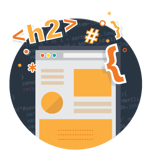
AP Computer Science Principles is an introductory college-level course designed for high school students who already know the basics of programming.
Like the previous course, this one is mostly focused on the College Board Framework, but it also aligns to a few specific CSTA standards:
- Level 3A, Algorithms & Programming
- Level 3B, Algorithms & Programming
Overall, CodeHS is an excellent resource for hitting every level of the Algorithms & Programming concepts.
However, if you teach younger students, the next resource could be a better fit!
3. Code.org
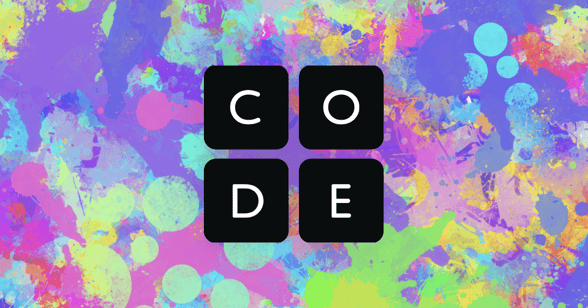
Code.org is one of the most well-known computer science resources for educators. This non-profit organization is specifically dedicated to providing better access to computer science education in schools.
Code.org has three main curriculum areas:
- CS Fundamentals
- CS Discoveries
- CS Principles
Each of these curriculum areas is geared towards a specific grade level and meets CSTA standards in those levels.
CS Fundamentals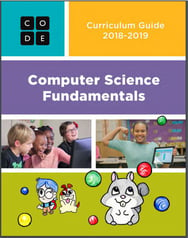
The CS Fundamentals curriculum is designed for students in grades K-5 and incorporates both paper and digital lessons.
CS Fundamentals mainly covers two portions of the CSTA standards:
- Level 1A, Algorithms & Programming
- Level 1B, Algorithms & Programming
CS Discoveries
CS Discoveries is Code.org’s curriculum designed for grades 6-10. 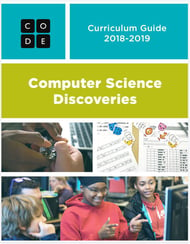 Even though it’s for middle school and high school students, this is still considered to be an introductory course.
Even though it’s for middle school and high school students, this is still considered to be an introductory course.
Overall, CS Discoveries aligns well with six cross-sections of the CSTA standards:
- Level 1B, Algorithms & Programming
- Level 1B, Computing Systems
- Level 2, Algorithms & Programming
- Level 2, Computing Systems
- Level 2, Data & Analysis
- Level 2, Impacts of Computing
CS Principles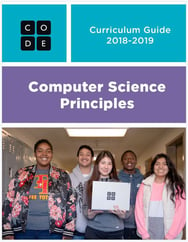
The CS Principles course is Code.org’s curriculum specifically designed for high school students. Because it includes more advanced content, Code.org notes that the curriculum can be used in either AP or non-AP courses.
In total, CS Principles aligns well with # CSTA standards:
- Level 2, Algorithms & Programming
- Level 2, Networks & the Internet
- Level 3A, Algorithms & Programming
- Level 3A, Computing Systems
- Level 3A, Data & Analysis
- Level 3A, Impacts of Computing
- Level 3A, Networks & the Internet
- Level 3B, Algorithms & Programming
- Level 3B, Data & Analysis
- Level 3B, Impacts of Computing
- Level 3B, Networks & the Internet
Overall, Code.org’s tiered curriculum will help you meet a wide variety of the CSTA standards across multiple grade levels.
It’s also an excellent resource for any computer teacher who needs to start teaching computer science.
How Will You Teach Computer Science?
We’ve shared three resources that teachers use to meet CSTA standards, but there are many other options out there.
